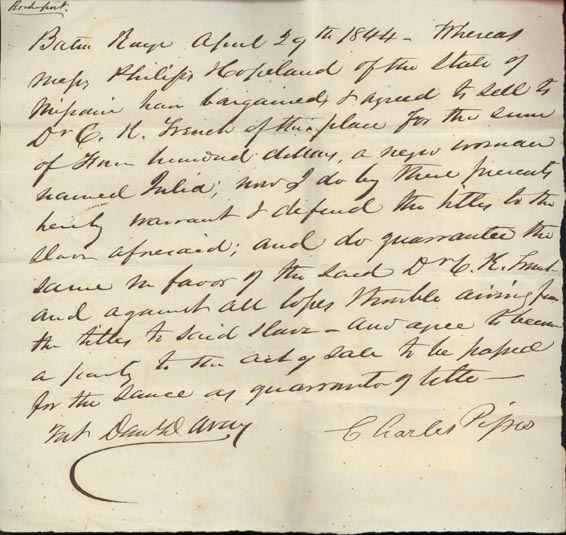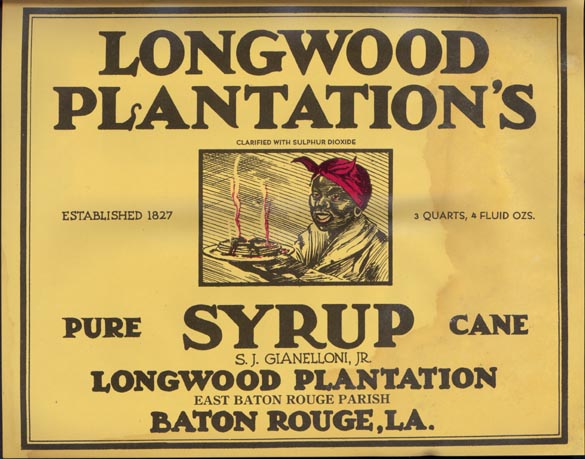
Case 8: African-Americans in Baton Rouge
Interpretive Text:
Twenty-five African slaves and two whites resided at the first settlement in Baton Rouge, founded in 1718. By 1860 the white population of Baton Rouge was 5,429, with a slave population of 1,247. As the hand-written bill of sale shows, slaves were bought and sold among the white citizens. During the Civil War, slaves brought within Union territory were known as contrabands. A broadside notes rules for them. After the Civil War, the number of African-Americans increased in Baton Rouge (52% in 1865 and 59% by 1880), but their lives barely improved. Rigid segregation was enforced throughout the century. Even blacks serving in the state legislature were banned from local business establishments. Stereotypical images of African-Americans, such as the Longwood Plantation advertisement, were common. No public education was available for black children until 1905. Only federal desegregation suits in the last half of the 20th century forced equal public education for African-Americans in Baton Rouge.
Southern University was authorized by the state constitution in 1879 but did not begin to prosper until 1914, when it moved from New Orleans to Baton Rouge. Its first president was Dr. Joseph S. Clark, who served from 1914 to 1938. Southern's campus includes Scott's Bluff where the "red stick" was said to have been seen by the French explorer Iberville. Today Southern enrolls 16,000 students and is the nation's largest predominately African-American institution.
Although some African-Americans students tried to enroll in LSU in 1946, the university did not admit African-Americans until the 1950s. In 1953 A. P. Tureaud, Jr. enrolled under court order, but his enrollment was cancelled when a higher court overturned the ruling. His case was ultimately decided by the U.S. Supreme Court. Tureaud returned to LSU in 1956. A classroom building on the LSU campus is named for his father, the late A. P. Tureaud, Sr., a noted Civil Rights leader.
The federal courts mandated full integration for LSU in 1964. The first African-American graduate of the LSU Law School was former New Orleans mayor, the late Ernest N. "Dutch" Morial. Kerry Pourciau was the first African-American to serve as Student Government President (1972-73); Lora O. Hinton, Jr. became the first African-American varsity football letterman in 1973-74; and in 1998-99, Herb Tyler was LSU's first African- American football quarterback. The first black woman to attend LSU was Freya Anderson Rivers, in 1964. The first to earn a Ph.D. from LSU was poet and educator Pinkie Gordon Lane.
Sharon Weston is the first African-American woman elected to the Louisiana State Legislature for East and West Baton Rouge parishes. She represents House District 29. First elected in 1991, Weston chairs the Municipal, Parochial, and Cultural Affairs Committee in the House, is a member of the Commerce and Executive committees, and chairs the East Baton Rouge Parish Legislative Delegation. In 1997 by the Baton Rouge Business Report cited her as one of the "Top 25 Most Influential Women for 1997 - Leading the Way in the Capital City."
Current publisher of the Baton Rouge Post , Willis V. Reed, first worked as a reporter for the paper in 1936. In 1983 Reed decided to revive the paper, which had been dormant for a number of years. In Reed's opinion "no other local paper adequately covers the activities and concerns of African-Americans in Baton Rouge." His paper is known for its balanced commentaries and criticisms, regardless of color, political position, or influence in the community.
African-American music and musicians play a strong part in Baton Rouge's cultural life. Johnny Adams, honored posthumously, was among the twelve recipients of the Rhythm & Blues Foundation's 1999 Pioneer Awards. Known as one of the last of the great blues and ballad singers, he was widely regarded as one of the finest singers associated with New Orleans R&B and jazz.
Items Displayed:
Items listed below were part of the exhibition but some are not pictured on this page.

Broadside "No Contrabands," Provost Marshall's Office, 1863. LLMVC, Baton Rouge Civil War Broadsides.

Lora O. Hinton, Jr. Varsity Letterman Plaque, 1973-1975. University Archives.
Pinkie Gordon Lane. Girl at the Window. Baton Rouge: LSU Press, 1991. LLMVC PS3562 A4845 G5 1991.
Baton Rouge Post. Courtesy of Willis V. Reed.
Johnny Adams. CD. Courtesy of Jo Jackson.
Photograph of Sharon Weston. Courtesy of Sharon Weston.
